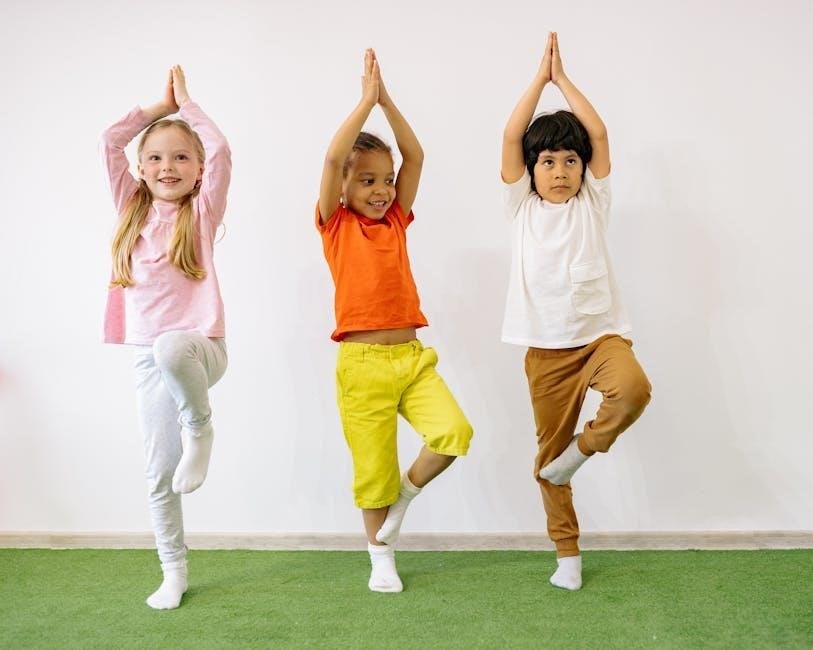
eureka math kindergarten pdf
Eureka Math Kindergarten PDF provides a comprehensive curriculum for early math education, focusing on foundational skills like counting, shapes, and basic operations. Designed to engage young learners, it emphasizes problem-solving and interactive activities to build a strong mathematical base. The program integrates hands-on experiences with structured lessons, fostering critical thinking and creativity in kindergarten students. This resource is ideal for teachers and parents seeking a well-organized approach to early math education, ensuring a smooth transition to higher-level concepts in the future.
Overview of the Curriculum
The Eureka Math Kindergarten curriculum is structured into six modules, each focusing on specific math skills to build a strong foundation. It begins with basic number sense and counting, progressing to shapes, addition, subtraction, and place value. The program emphasizes hands-on learning through manipulatives and real-world applications, making math engaging and accessible for young learners. Each module includes detailed lesson plans, problem sets, and fluency activities to ensure mastery of concepts. The curriculum is designed to foster critical thinking, creativity, and problem-solving skills, preparing students for future math education. With a focus on clarity and coherence, Eureka Math provides a comprehensive framework for teaching kindergarten mathematics effectively.
Importance of Early Math Education
Early math education lays the foundation for future academic success, fostering critical thinking and problem-solving skills. Eureka Math Kindergarten PDF emphasizes the importance of introducing mathematical concepts early, helping children develop number sense, spatial awareness, and logical reasoning. These skills are essential for building confidence and curiosity in young learners. By engaging with math at an early age, children gain a strong understanding of basic principles, which supports their ability to tackle more complex concepts as they progress. Early math education also enhances cognitive development, improving memory, attention, and analytical abilities. It creates a lifelong love for learning and prepares students to excel in math and other subjects throughout their educational journey.
Structure of the Eureka Math Kindergarten Program
The Eureka Math Kindergarten program is thoughtfully structured to introduce young learners to essential math concepts through a series of engaging and interactive modules. The curriculum is divided into six main modules, each focusing on specific skills such as counting, shapes, addition, subtraction, and place value. The program begins with foundational number sense and progresses to more complex ideas like comparing numbers and analyzing shapes. Lessons are designed to incorporate hands-on activities, visual aids, and real-world applications, ensuring students stay motivated and involved. The structured approach allows for a natural progression of skills, building confidence and readiness for more advanced math in later grades. Each module includes detailed lesson plans, practice exercises, and assessments to track student progress effectively.
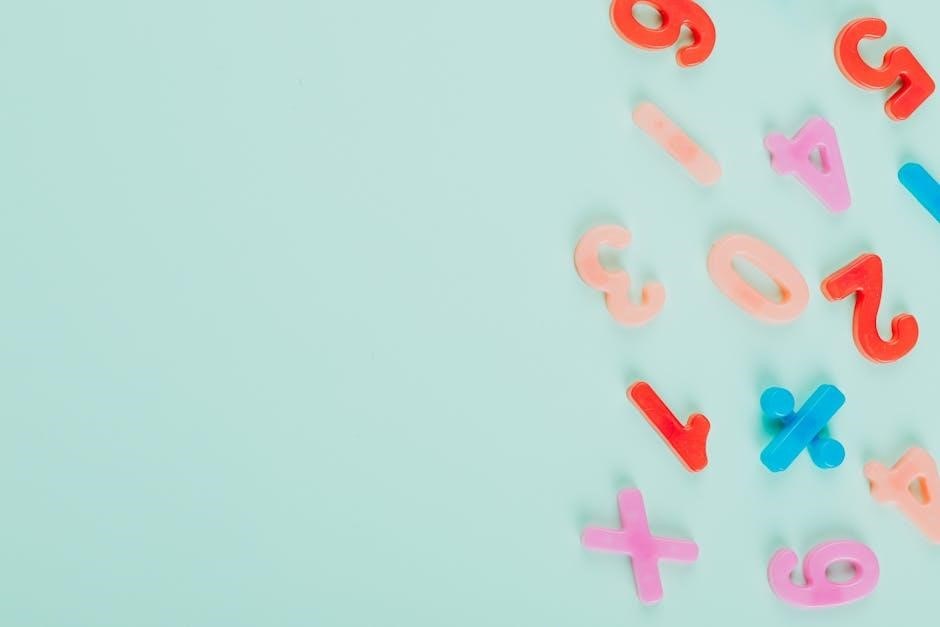
Module 1: Numbers to 10
Module 1 focuses on developing foundational counting skills and number sense up to 10. It introduces number bonds and decomposition, preparing students for basic addition and subtraction concepts.
Counting and Basic Number Sense
Counting and basic number sense are foundational skills introduced in Module 1 of Eureka Math Kindergarten. Students learn to recite numbers in sequence, identify numbers up to 10, and understand their representation. Activities include counting objects in various configurations, such as lines, arrays, or scattered groups, helping children develop one-to-one correspondence. The curriculum emphasizes recognizing numbers in different contexts, such as dot sets or five-frames, to build conceptual understanding. These lessons lay the groundwork for addition and subtraction by introducing number bonds and decomposition. Interactive tools like manipulatives and number lines are used to engage young learners, fostering a strong mathematical foundation. Parents are encouraged to support this learning through counting games and real-world applications.
Number Bonds and Decomposition
Number bonds and decomposition are key concepts in Module 1 of Eureka Math Kindergarten, helping students understand how numbers can be broken down into smaller parts. For example, the number 5 can be split into 2 and 3. This skill is introduced through hands-on activities, such as using blocks or drawings to represent parts of a whole. Students learn to express numbers in different ways, fostering flexibility in problem-solving. Decomposition is also applied to basic addition and subtraction, preparing children for more complex math in the future. Interactive tools and manipulatives are used to make learning engaging and concrete, ensuring a strong foundation in number sense and mental math strategies.
Comparing Numbers
Comparing numbers is a fundamental skill introduced in Module 1 of the Eureka Math Kindergarten curriculum. Students learn to identify and express which number is larger or smaller, using visual aids like blocks, number lines, and counting tools. This concept is reinforced through hands-on activities that encourage children to use comparison language, such as “more than” or “fewer than.” The curriculum also introduces basic comparison symbols (e.g., >, <, =) to help students visualize relationships between numbers. By engaging in these exercises, kindergartners develop a deeper understanding of number relationships and build a strong foundation for future math skills. Interactive and manipulative-based lessons ensure that comparing numbers is both fun and meaningful for young learners.
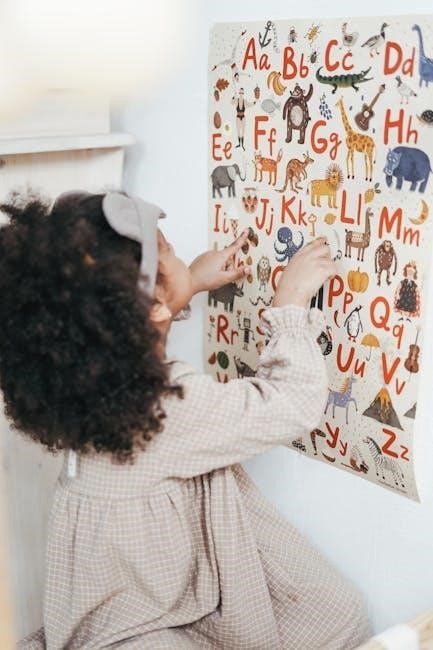
Module 2: Shapes and Space
Module 2 focuses on identifying and exploring two-dimensional and three-dimensional shapes. Students learn to recognize, name, and compare shapes like squares, circles, and triangles. Activities include sorting games and manipulatives to develop spatial awareness and visual recognition skills, laying the groundwork for geometry and problem-solving abilities in young learners.
Identifying Two-Dimensional Shapes
This section introduces kindergarten students to basic two-dimensional shapes, such as squares, circles, triangles, and rectangles; Activities focus on recognizing and naming shapes through visual identification and hands-on exploration. Students engage in sorting games, shape scavenger hunts, and drawing exercises to build familiarity. The curriculum emphasizes understanding shape properties, like the number of sides and corners, using manipulatives such as wooden blocks and digital tools. These foundational skills help students develop spatial awareness and visual recognition, essential for future geometry and problem-solving tasks. Interactive activities encourage creativity and collaboration, making learning shapes an enjoyable and engaging experience for young learners.
Exploring Three-Dimensional Shapes
This section of the Eureka Math Kindergarten PDF introduces students to three-dimensional shapes, such as cubes, cylinders, cones, and spheres. Activities encourage students to identify and describe these shapes by observing their attributes, like faces, edges, and vertices. Hands-on experiences with real-world objects, such as stacking blocks or analyzing household items, help students understand the differences between 2D and 3D shapes. Visual aids and manipulatives, such as geometric solids, are used to enhance learning. Interactive games and sorting activities further reinforce shape recognition and spatial awareness. By exploring these shapes, students develop essential skills in geometry and problem-solving, laying a strong foundation for advanced math concepts in later grades.
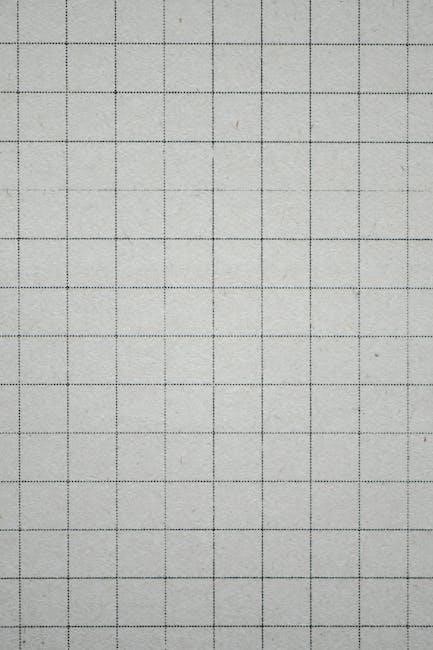
Module 3: Addition and Subtraction Concepts
Module 3 introduces kindergarten students to basic addition and subtraction concepts through hands-on activities and real-world problems. Using manipulatives, students explore combining and separating objects to solve simple math problems, building a strong foundation for arithmetic operations and problem-solving skills.
In Eureka Math Kindergarten, the introduction to addition begins with hands-on activities using objects like blocks or counters. Students learn to combine sets of objects to find the total, using counting and basic number sense; The curriculum emphasizes the concept of “putting together” groups, which helps students understand the fundamental idea of addition. Lessons are designed to make math engaging and accessible, with visual aids and manipulatives to support learning. By connecting addition to real-world scenarios, the program helps kindergartners develop a strong foundation for arithmetic operations and problem-solving skills, preparing them for more complex math concepts in the future.
Basic Subtraction Concepts
Eureka Math Kindergarten introduces subtraction as the inverse of addition, focusing on “taking apart” groups to find a remaining amount. Students engage in hands-on activities using manipulatives like blocks or counters to explore basic subtraction concepts. The curriculum emphasizes understanding subtraction through real-world scenarios, such as removing objects from a set. Visual aids and number bonds help students visualize the process of subtraction, making it intuitive and accessible. By connecting subtraction to addition, the program reinforces the relationship between these operations. Problem-solving strategies like counting backward and using number lines are introduced to build foundational arithmetic skills. These activities ensure kindergartners develop a solid understanding of subtraction, preparing them for more complex math concepts in the future.

Module 4: Numbers 10-20
Counting to 20
Eureka Math Kindergarten Module 4 introduces counting to 20, focusing on various configurations such as lines, arrays, and circles. Students learn to identify and count objects up to 20, developing their understanding of number relationships and sequence. Activities include using number lines and manipulatives to reinforce counting skills, ensuring a strong foundation in numeracy. This module builds on earlier concepts, preparing students for more complex number operations in subsequent lessons.
In Eureka Math Kindergarten Module 4, students explore counting to 20 through engaging activities that emphasize number sense and sequence. Lessons introduce counting in groups, arrays, and various configurations, helping children understand the relationship between numbers and quantities. Interactive tools like number lines and manipulatives are used to reinforce counting skills, ensuring a strong foundation in numeracy. The module also incorporates math drawings and expressions, allowing students to visualize and communicate their understanding of numbers up to 20. By practicing counting in different contexts, kindergartners develop fluency and confidence, preparing them for more complex number operations in future modules. This hands-on approach fosters a deep understanding of numerical concepts essential for long-term math success.
Understanding Place Value
In Eureka Math Kindergarten Module 4, students begin to explore the concept of place value through hands-on activities and visual representations. Lessons introduce the idea of ones and tens, using manipulatives like blocks or number lines to demonstrate how numbers can be broken down into smaller parts. For example, the number 15 is shown as one ten and five ones, helping students grasp the relationship between digits and their positions. This foundational understanding is crucial for future math skills, such as addition and subtraction with regrouping. Interactive exercises and math drawings encourage students to express their understanding of place value, building confidence and readiness for more complex number operations in higher grades.
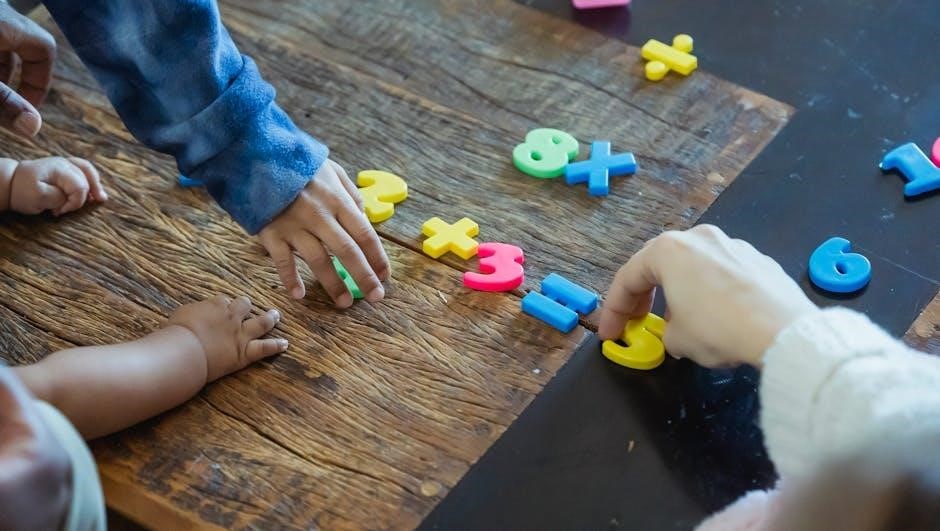
Module 5: Analyzing and Comparing Shapes
Eureka Math Kindergarten Module 5 focuses on analyzing and comparing shapes, introducing students to composing, decomposing, and sorting shapes through interactive activities and visual tools.
Composing and Decomposing Shapes
In this section, students learn to break down and reassemble shapes using hands-on activities. They explore how basic shapes can combine to form more complex figures, enhancing spatial awareness and problem-solving skills. Visual aids and manipulatives help young learners understand geometric relationships, preparing them for advanced math concepts. Interactive exercises encourage creativity, fostering a deeper connection to geometry and its practical applications.
Sorting and Categorizing Shapes
Students engage in sorting and categorizing shapes, developing their ability to recognize and name basic geometric figures. This activity enhances spatial awareness and mathematical vocabulary. By grouping shapes based on attributes like color, size, or number of sides, students build foundational skills for geometry. Interactive exercises, such as using manipulatives like blocks or tiles, encourage hands-on learning and problem-solving. This process helps young learners understand relationships between shapes and prepares them for more complex mathematical concepts. The curriculum emphasizes the importance of visual recognition and classification, fostering a strong understanding of shapes and their properties. These skills are essential for future math education and critical thinking.
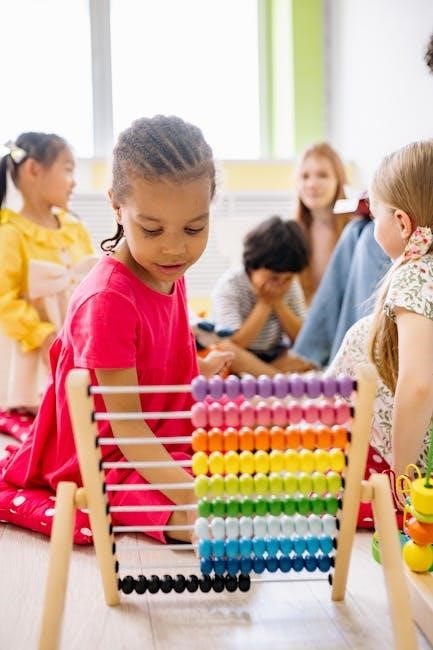
Module 6: Counting to 100
Module 6 focuses on counting to 100, building fluency and number sense. Students practice counting in groups, using number lines, and understanding place value concepts. Activities include skip counting, number patterns, and identifying numbers up to 100. These exercises help students develop a strong foundation in numeracy, preparing them for more complex math operations. Interactive games and manipulatives are used to make learning engaging and effective. This module ensures students can count accurately, recognize number sequences, and understand the relationship between numbers, fostering confidence in their mathematical abilities. The lessons are designed to be fun and challenging, promoting a lifelong love of learning mathematics.
Counting in Groups
Counting in groups is a foundational skill introduced in Module 6 of the Eureka Math Kindergarten PDF curriculum; Students learn to count objects arranged in groups of 2, 5, or 10, developing their understanding of place value and number relationships. This method helps children transition from counting individual items to recognizing larger sets, building fluency and accuracy. Activities include using number lines to identify missing numbers and skip counting to reinforce patterns. By counting in groups, students gain confidence in their ability to work with larger numbers, preparing them for more complex math concepts. This approach makes learning engaging and practical, ensuring a strong foundation in numeracy.
Using Number Lines
Using number lines is a key strategy in the Eureka Math Kindergarten PDF curriculum, helping students visualize and understand the relationships between numbers. Number lines are introduced as tools for counting, comparing, and solving simple addition and subtraction problems. Students learn to move objects or tokens along the line to demonstrate their understanding of sequences and quantities. This hands-on approach reinforces number sense and prepares children for more complex math concepts. By practicing with number lines, kindergartners develop fluency in counting forward and backward, identifying missing numbers, and recognizing patterns. These skills lay the groundwork for future math success, making number lines an essential part of the Eureka Math learning experience.
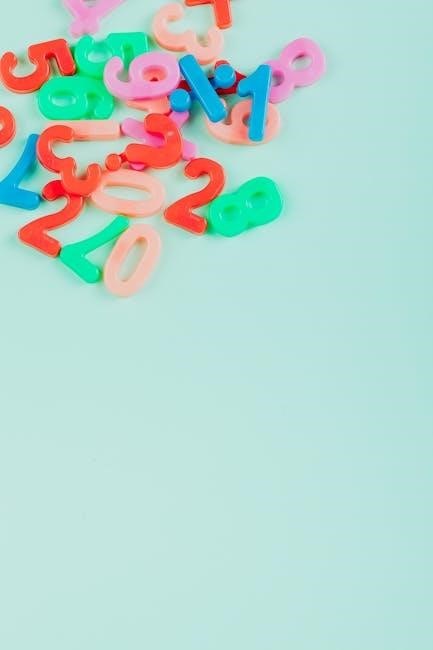
Fluency Practice in Eureka Math
Fluency Practice in Eureka Math involves daily activities that reinforce foundational math skills through repetition and interactive tools. These exercises help kindergarten students build confidence and speed in problem-solving, ensuring a strong foundation for future math education.
Daily Fluency Activities
Daily fluency activities in Eureka Math Kindergarten are designed to help students develop quick recall and accuracy with foundational math skills. These activities include counting games, number bond exercises, and shape recognition tasks. Teachers use interactive tools like number lines, counters, and flashcards to make learning engaging. Fluency practice is incorporated into daily routines, ensuring consistency and progress. For example, students might count objects in groups or identify shapes in their environment. These exercises build confidence and prepare students for more complex math concepts in later modules. By reinforcing skills regularly, Eureka Math helps kindergartners develop a strong mathematical foundation.
Games and Interactive Tools
Eureka Math Kindergarten incorporates engaging games and interactive tools to make learning math enjoyable and effective. These resources include hands-on activities like number lines, counting games, and shape sorters. Digital tools, such as interactive whiteboard exercises, allow students to explore concepts visually. Games like “Number Bond Match” and “Shape Puzzles” encourage active participation and collaboration. These tools help students develop problem-solving skills and build confidence in their math abilities. By integrating play with learning, Eureka Math creates a dynamic environment that fosters a love for mathematics from an early age, ensuring kindergartners are well-prepared for future challenges.
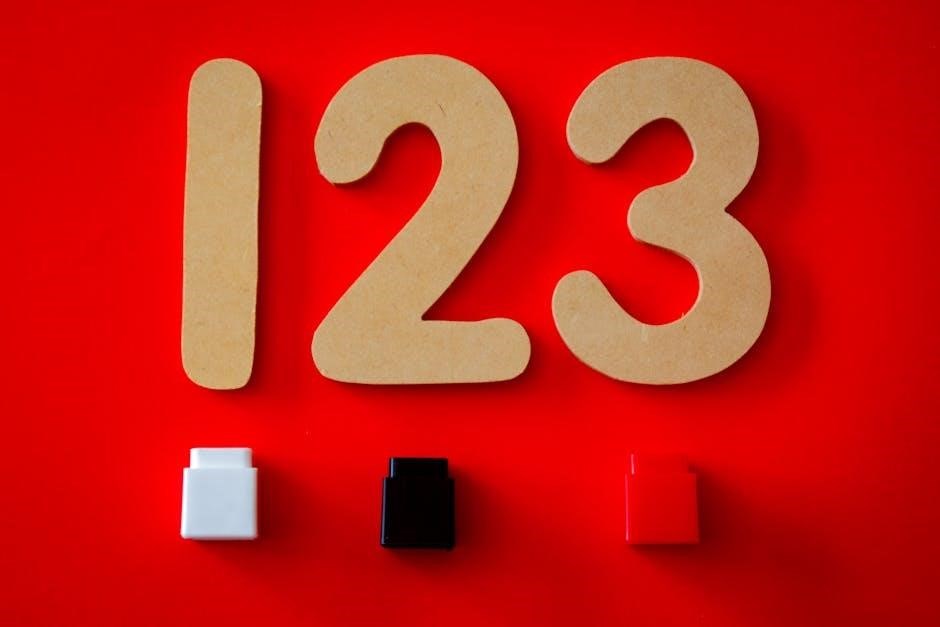
Problem-Solving Strategies
Eureka Math encourages the use of manipulatives, math drawings, and expressions to foster critical thinking and creativity in solving problems. These strategies help build a strong mathematical foundation.
Using Manipulatives
Manipulatives play a crucial role in Eureka Math, offering hands-on experiences for kindergarten students to explore mathematical concepts. Tools like blocks, counters, and geometric shapes help visualize abstract ideas, making learning interactive and engaging. These physical objects allow students to experiment with number bonds, decompose numbers, and understand place value. Manipulatives also facilitate comparisons of lengths, weights, and capacities, aiding in the development of spatial awareness and logical reasoning. By using manipulatives, students can construct their understanding of math through tangible representations, fostering a deeper connection to the material and building a strong foundation for future learning.
Math Drawings and Expressions
Math drawings and expressions are integral to Eureka Math, enabling kindergarten students to visually represent and communicate mathematical ideas. By drawing shapes, numbers, and objects, students can illustrate their understanding of concepts like number bonds and basic operations. This method encourages creativity and clarity in problem-solving. For instance, students might draw a picture to show how blocks can be grouped or separated to solve an addition or subtraction problem. These visual expressions align with educational standards, helping students articulate their thinking and develop a deeper grasp of mathematical relationships. Drawing also supports the development of fine motor skills and enhances engagement in the learning process.
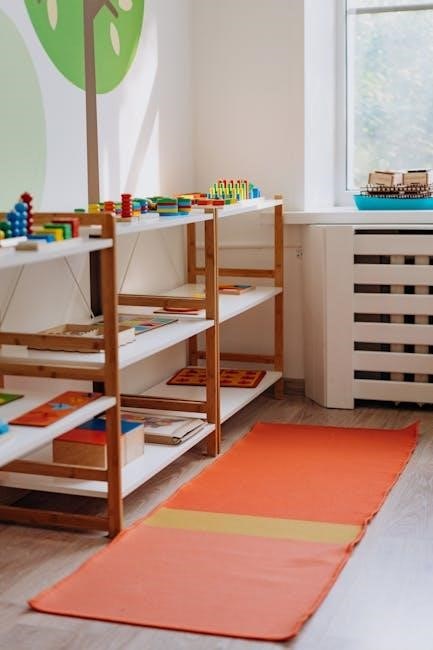
Parental Involvement
Eureka Math encourages parents to support their child’s learning through guided activities and resources, fostering a strong home learning environment and collaboration with teachers to enhance math skills.
Supporting Learning at Home
Eureka Math provides parents with tools to support their child’s math education at home. The curriculum includes a Parent Guide that offers tips and activities to reinforce classroom learning. Daily fluency practices, such as counting games and number bonding exercises, can be easily incorporated into routines. Parents are encouraged to use manipulatives like blocks or counters to help children visualize concepts. By engaging in these activities, parents foster a deeper understanding of math principles and build their child’s confidence. The program also emphasizes communication with teachers to ensure a cohesive learning experience. This collaborative approach helps create a strong foundation for future academic success.
Communicating with Teachers
Effective communication between parents and teachers is crucial for a child’s success in the Eureka Math program. Regular updates from teachers provide insights into curriculum goals and a child’s progress. Parents can attend parent-teacher conferences or use digital platforms to stay informed. The Eureka Math Parent Guide offers tips for discussing math concepts with teachers, ensuring alignment between classroom and home learning. Open communication helps address any challenges early and fosters a collaborative approach to education. By maintaining regular dialogue, parents and teachers can work together to support the child’s mathematical development and build a strong foundation for future learning.
The Eureka Math Kindergarten PDF effectively prepares young learners for future math education by fostering foundational skills, problem-solving, and creativity, ensuring long-term academic success and confidence.
Long-Term Benefits of Eureka Math
Eureka Math Kindergarten PDF provides a strong foundation for future math education by developing problem-solving skills, critical thinking, and creativity. The curriculum’s focus on number sense, shapes, and basic operations equips students with essential tools for understanding more complex concepts in later grades. By fostering a deep understanding of mathematical principles early on, Eureka Math helps students build confidence and a positive attitude toward math. This structured approach ensures long-term academic success, as students are well-prepared to tackle challenges in higher-level math with ease and resilience. The interactive and engaging nature of the program also encourages a lifelong love for learning and intellectual growth.
Preparing for Future Math Education
Eureka Math Kindergarten PDF lays a robust foundation for future math education by introducing essential concepts and skills. The curriculum emphasizes number sense, decomposition, and problem-solving strategies, which are critical for advanced math. Students develop the ability to think logically and approach problems methodically, preparing them for algebra and higher-level mathematics. The program’s focus on shapes, counting, and basic operations ensures a smooth transition to more complex topics. By fostering resilience and confidence, Eureka Math equips students with the tools needed to excel in math throughout their academic journey. This structured approach ensures readiness for upcoming challenges, making it an invaluable resource for long-term math education success.